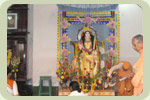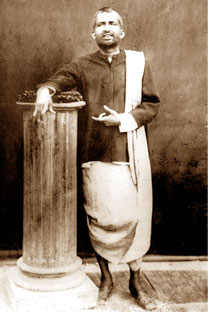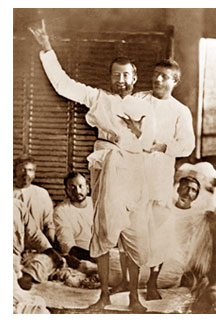Throughout each of the years under review, in addition to the curriculum, the students and staff were busily engaged in various extra-curricular and co-curricular activities such as excursions, trekking, rock-climbing and nature-study camps organized by the Himapathik Club . Value Orientation Camps on Value Sharing and Pratyahara Yoga organized by the Vivekananda Nidhi, work projects, physical activities including Annual Sports, participating in Science Aptitude and Talent Search Tests, Geography Talent Search Tests, Mathematics Quiz-cum-Quest Competitions organized by the Centre for Pedagogical Studies in Mathematics,Cultural Competitions organized by Kolkata Ramakrishna Vivekananda Bhav Prachar Parishad, Uttar Kolkata Vivekananda Juba Mahamondal, Students' Health Home , Seminars, Yogasan Contest, Stamp Contest, Inter-school Competitions in Recitations, Elocution, Debate, Quiz, Essay Writing, Painting, Music etc. and joining processions organized by the Ramakrishna Mission in connection with the birthday of Sri Ramakrishna and Swami Vivekananda.


Free Coaching Classes ---
Were started in 1988 for the poor children of the neighbourhood. Classes are held in the Christine Bhavan from 7 to 9 in the morning on four days a week. The children are given free tiffin on those days. Books and new clothes are also provided. Students are taken to excursions to places of interest. They too participate in various extra curricular activities.Medical Camp ---
A free Medical Camp is conducted once a month since March 2000 on the first Sunday of each month in collaboration with the Satberia Village Welfare Mission.
Computer Education ---
The school has 6 computers including a multi-media. The students of the Secondary Section from Class V to X are given ample opportunity to learn the use of computers. The computer education has been started in our Primary Section too. This section has 7 computers. The students of classes I to IV are provided opportunity to learn the use of computer instructed by 2 teachers. It imparts free computer education to needy students only.
Spoken English Classes ---
Spoken English classes have been introduced from classes I to VI since April,2006. The students of both the section are provided ample scope to learn communicative English through these classes. 5 teachers have been appointed by Sri Sarada Math, Rasik Bhita, Shiksha O Sanskriti Peetha, Dakshineswar. It imparts free education to needy students also.
School Magazine ---
The Nivedita Balika Vidyalaya Patrikawas published in 2005 and 2008 and it maintained its traditional literary standard. The Magazine included a Report of various extra-curricular activities such as excursions undertaken, Inter-school competitions participated, prizes won and cultural programmes organized by the pupils of the Primary and the Secondary Sections.

Celebrations ---
As bees swarm around a fully blossomed flower, devotees now started coming to Sri Ramakrishna. He divided them into two categories. The first one consisted of householders. He taught them how to realize God while living in the world and discharging their family duties. The other more important category was a band of educated youths, mostly from the middle class families of Bengal, whom he trained to become monks and to be the torchbearers of his message to mankind. The foremost among them was Narendranath, who years later, as Swami Vivekananda, carried the universal message of Vedanta to different parts of the world, revitalized Hinduism, and awakened the soul of India.
The Gospel of Sri Ramakrishna ---
Sri Ramakrishna did not write any book, nor did he deliver public lectures. Instead, he chose to speak in a simple language using parables and metaphors by way of illustration, drawn from the observation of nature and ordinary things of daily use. His conv ersations were charming and attracted the cultural elite of Bengal. These conversations were noted down by his discipleMahendranath Gupta who published them in the form of a book, Sri Sri Ramakrishna Kathamrita in Bengali. Its English rendering, The Gospel of Sri Ramakrishna, was released in 1942; it continues to be increasingly popular to this day on account of its universal appeal and relevance.
ersations were charming and attracted the cultural elite of Bengal. These conversations were noted down by his discipleMahendranath Gupta who published them in the form of a book, Sri Sri Ramakrishna Kathamrita in Bengali. Its English rendering, The Gospel of Sri Ramakrishna, was released in 1942; it continues to be increasingly popular to this day on account of its universal appeal and relevance.
Last Days ---
The intensity of his spiritual life and untiring spiritual ministration to the endless stream of seekers told on Sri Ramakrishna's health. He developed cancer of the throat in 1885. He was shifted to a spacious suburban villa where his young disciples nursed him day and night. He instilled in them love for one another, and thus laid the foundation for the future monastic brotherhood known as Ramakrishna Math. In the small hours of 16 August 1886 Sri Ramakrishna gave up his physical body, uttering the name of the Divine Mother, and passed into Eternity.
The System of Training in Sarada Mandir(Boarding) ---
In the Mandir, the student-boarders receive a training based on Indian culture and traditions under the fostering care of the resident sisters. The Mandir has a big shrine of its own. Girls attend prayers morning and evening, perform some household duties and lead a simple life in an environment favourable to the growth of their character. They share the work of the shrine and perform Shiva Puja in the Bengali month of Vaisakha. Physical exercise is compulsory. Arrangements are made for occasional visits to holy places and other places of interest. Gita class is conducted once a week and scriptural and religious discourses are arranged for the benefit of the students from time to time specially on occasions like Janmastami, Ramanavami, Buddha Purnima, Rathayatra and in connection with the birthdays of Sri Ramakrishna , the Holy Mother, Swami Vivekananda and the other disciples of Sri Ramakrishna, Sri Shankaracharya and Jesus Christ.